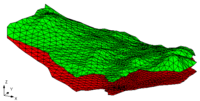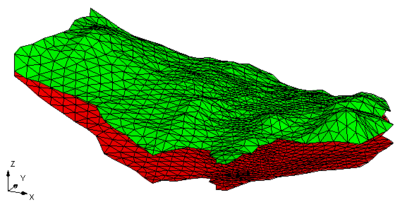GMS:TIN Module
TIN stands for Triangulated Irregular Network. TINs are used for surface modeling. TINs are formed by connecting a set of XYZ points with edges to form a network of triangles. TINs can be used to represent the surface of a geologic unit or the surface defined by a mathematical function.
TINs in GMS can be created manually, imported, or created from other data objects. By default, GMS uses the Delaunay criterion to triangulate TINs.
GMS provides a variety of tools and commands for manipulating TINs. TINs can be contoured, displayed in oblique view with mapped images and hidden surfaces removed, and have several other display options that can be set to visualize and understand the terrain surface better. GMS also contains custom settings for using TINs and allows TINs to be converted into other types of data, including solid models and 3D meshes. Through GMS it is possible to both import and export TIN files.
Several TINs can be modeled at once in GMS. One of the TINs is designated as the "active" TIN. The selection and editing tools apply to the active TIN only.
The TIN Module can be added to a paid edition of GMS.
| GMS – Groundwater Modeling System | ||
|---|---|---|
| Modules: | 2D Grid • 2D Mesh • 2D Scatter Point • 3D Grid • 3D Mesh • 3D Scatter Point • Boreholes • GIS • Map • Solid • TINs • UGrids | |
| Models: | FEFLOW • FEMWATER • HydroGeoSphere • MODAEM • MODFLOW • MODPATH • mod-PATH3DU • MT3DMS • MT3D-USGS • PEST • PHT3D • RT3D • SEAM3D • SEAWAT • SEEP2D • T-PROGS • ZONEBUDGET | |
| Aquaveo | ||

